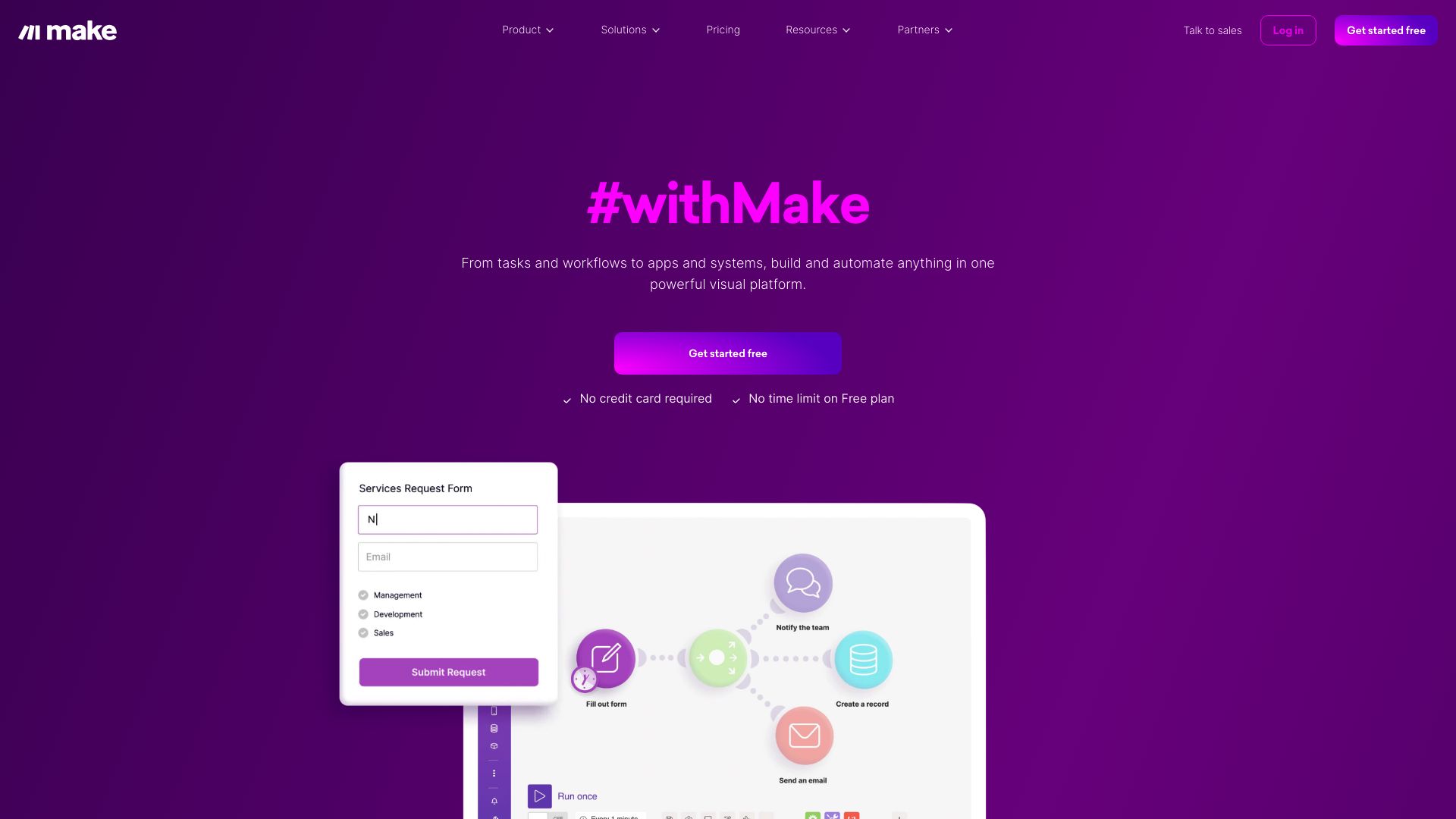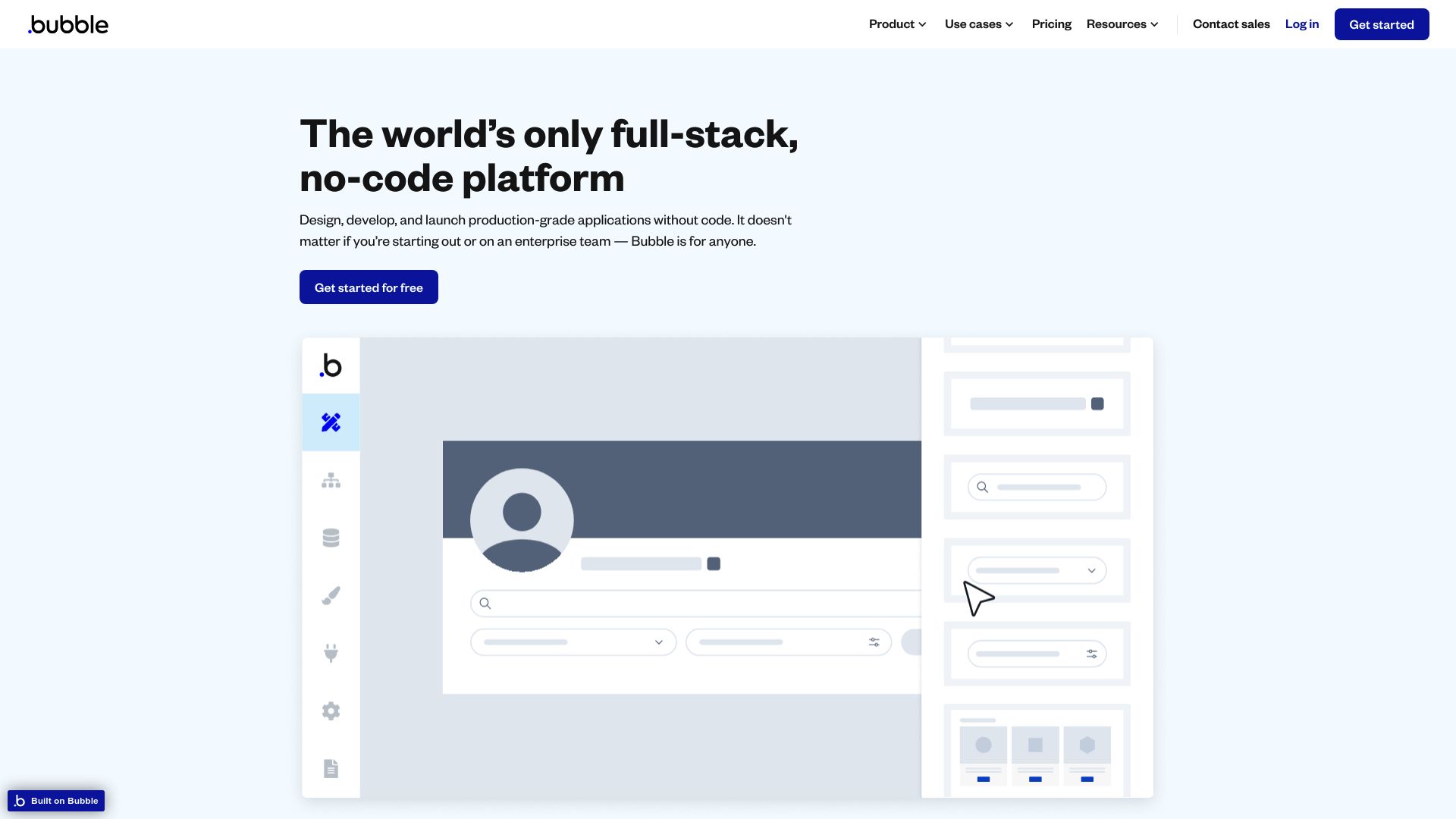Make.com vs. Bubble: Which AI Automation Platform Fits Your Needs?
AI technology continues to reshape how businesses operate, automate tasks, and make decisions. As companies seek powerful yet accessible solutions to harness AI’s potential, platforms like Make.com vs. Bubble, and SmythOS have emerged as leading options. This comparison examines how these tools empower users to create AI-powered workflows and applications, exploring their key features, strengths, and limitations.
Whether you’re a developer looking to streamline processes, a business leader evaluating enterprise-grade AI solutions, or an entrepreneur seeking no-code options, this analysis will help you navigate the landscape of AI automation platforms and choose the solution best suited for your needs.
Make.com Overview
Make.com empowers users to create powerful automated workflows without coding. The visual platform connects over 1000 apps and services, enabling businesses to streamline processes and boost productivity.


Make.com’s drag-and-drop interface allows users to build complex scenarios by linking actions across multiple apps. Marketing teams can automate lead nurturing, sales departments can synchronize CRM data, and IT teams can create custom integrations. The platform scales from individual users to enterprise deployments.
Make.com empowers users to create powerful automated workflows without coding. The visual platform connects over 1000 apps and services, enabling businesses to streamline processes and boost productivity.
Key features include a visual workflow builder, scheduling capabilities, and detailed execution logs for monitoring and troubleshooting. Make.com supports OAuth authentication and provides robust data transformation tools. While not focused on AI agents, it excels at connecting disparate systems and automating repetitive tasks.
Make.com lacks some advanced AI capabilities found in dedicated agent builders. It doesn’t offer hosted AI agents, memory and context features, or autonomous problem-solving. However, its strength lies in its extensive app integrations and accessibility for non-technical users seeking powerful automation.
Bubble Overview
Bubble empowers users to create web applications without writing code. This no-code development platform features a drag-and-drop interface, making it accessible to both technical and non-technical users. Bubble’s visual editor allows for rapid prototyping and development of complex web applications, from simple landing pages to sophisticated marketplaces.
The platform excels in its integration capabilities, particularly with AI services. Bubble offers plugins and API connectors that simplify the incorporation of advanced AI functionalities like chatbots, content generation, and image processing. This flexibility enables developers to harness cutting-edge AI technologies without deep expertise in machine learning or natural language processing.
Bubble’s marketplace of pre-made templates and plugins accelerates development, allowing users to quickly implement common features and designs. The platform’s collaboration tools support team-based development, with features like version control and real-time editing. Built on Amazon Web Services, Bubble provides robust infrastructure with built-in security features, including GDPR compliance and SOC 2 Type II certification.


Bubble empowers users to create web applications without writing code. This no-code development platform features a drag-and-drop interface, making it accessible to both technical and non-technical users.
While Bubble offers significant advantages in rapid application development, it has limitations. The platform’s learning curve can be steep for complex applications, and performance may suffer for highly data-intensive operations. Additionally, while Bubble provides extensive customization options, it may not offer the same level of fine-grained control as traditional coding for certain specialized functions.
Bubble positions itself as a democratizing force in software development, aiming to make application creation accessible to a broader audience. This vision aligns with the growing demand for no-code solutions in business environments where speed and agility in application development are crucial. As Bubble continues to evolve, its focus on integrating AI directly into the editor promises to further simplify and enhance the app-building process for users across various industries.
Feature Comparison
Make.com and Bubble offer distinct approaches to application development and automation, each with its own strengths and limitations. Make.com excels in workflow automation and app integration, providing a visual interface for connecting over 1000 apps and services. Its drag-and-drop scenario builder allows users to create complex automated workflows without coding. In contrast, Bubble focuses on web application development, offering a visual interface for building full-fledged web apps without traditional programming.
Make.com’s strength lies in its extensive app integrations and powerful data manipulation tools. It supports OAuth authentication, detailed execution logs, and robust scheduling capabilities. However, Make.com lacks some advanced AI features found in dedicated agent builders. It doesn’t offer hosted AI agents, memory and context features, or autonomous problem-solving capabilities.
Bubble, while powerful for web app development, also has limitations in AI-specific features. It provides easy integration with AI services through plugins and API connectors, but doesn’t offer native AI agent hosting or advanced AI-specific tools like autonomous agents or multi-agent collaboration. Bubble’s focus on web applications means it excels in areas like user interface design and database management, but may not be as flexible for complex, AI-driven automation tasks.
Both platforms have gaps in core AI components compared to dedicated AI agent builders like SmythOS. Neither offers features like hosted AI agents, memory and context management, or autonomous problem-solving capabilities. In terms of security, while both platforms offer data encryption and OAuth support, they lack more advanced features like constrained alignment for AI behavior control.
Feature Comparison Table
| Make.com | Bubble | SmythOS | |
|---|---|---|---|
| CORE FEATURES | |||
| AI Agents | ❌ | ✅ | ✅ |
| Hosted Agents (Dev, Production) | ❌ | ✅ | ✅ |
| Environments (Dev, Production) | ❌ | ✅ | ✅ |
| Memory & Context | ❌ | ❌ | ✅ |
| Autonomous Agents | ❌ | ❌ | ✅ |
| Explainability & Transparency | ❌ | ❌ | ✅ |
| Multimodal | ❌ | ❌ | ✅ |
| Problem-Solving Capabilities | ❌ | ✅ | ✅ |
| Multi-Agent Collaboration | ❌ | ❌ | ✅ |
| Human-AI Interaction | ❌ | ✅ | ✅ |
| Bulk Work | ✅ | ❌ | ✅ |
| Agent Work Scheduler | ✅ | ❌ | ✅ |
| SECURITY | |||
| Constrained Alignment | ❌ | ❌ | ✅ |
| Data Encryption | ❌ | ✅ | ✅ |
| IP Control | ❌ | ❌ | ✅ |
| COMPONENTS | |||
| Foundation AIs | ❌ | ✅ | ✅ |
| Huggingface AIs | ❌ | ❌ | ✅ |
| Zapier APIs | ❌ | ✅ | ✅ |
| Classifiers | ❌ | ❌ | ✅ |
| Data Lakes | ❌ | ✅ | ✅ |
| DEPLOYMENT OPTIONS (EMBODIMENTS) | |||
| Deploy as API | ❌ | ❌ | ✅ |
| Staging Domains | ❌ | ✅ | ✅ |
| Production Domains | ❌ | ✅ | ✅ |
| Deploy as Site Chat | ❌ | ✅ | ✅ |
| Deploy as Scheduled Agent | ✅ | ❌ | ✅ |
| DATA LAKE SUPPORT | |||
| Hosted Vector Database | ❌ | ❌ | ✅ |
| Sitemap Crawler | ❌ | ❌ | ✅ |
| YouTube Transcript Crawler | ❌ | ❌ | ✅ |
| URL Crawler | ❌ | ❌ | ✅ |
| PDF Support | ❌ | ✅ | ✅ |
| Word File Support | ❌ | ✅ | ✅ |
| TXT File Support | ❌ | ✅ | ✅ |
Best Alternative to Make.com and Bubble
SmythOS offers a powerful alternative to Make.com and Bubble, combining the best of both worlds in a comprehensive AI automation platform. Our solution stands out with its advanced AI capabilities, seamless integration options, and user-friendly interface, making it the superior choice for businesses seeking to harness the full potential of AI.
Unlike Make.com and Bubble, SmythOS provides hosted AI agents for both development and production environments. This feature allows for seamless testing and deployment of AI solutions, streamlining the development process and reducing time-to-market. Our platform also offers memory and context management, enabling AI agents to maintain conversation history and provide more coherent and context-aware responses.
SmythOS excels in autonomous agent capabilities, a feature lacking in both Make.com and Bubble. Our agents can operate independently, making decisions and performing tasks without constant human intervention.
SmythOS excels in autonomous agent capabilities, a feature lacking in both Make.com and Bubble. Our agents can operate independently, making decisions and performing tasks without constant human intervention. This autonomy translates to increased efficiency and reduced workload for your team. Additionally, our multi-agent collaboration feature enables complex problem-solving by allowing multiple AI agents to work together, a capability not offered by either Make.com or Bubble.
We prioritize explainability and transparency in AI operations, providing users with insights into how decisions are made. This feature is crucial for businesses that require accountability and need to understand the reasoning behind AI actions. SmythOS also supports a wide range of deployment options, including APIs, webhooks, site chats, and scheduled agents, offering flexibility that surpasses both Make.com and Bubble.
With SmythOS, you’re not just getting a tool; you’re investing in a complete AI ecosystem that grows with your needs. From our intuitive drag-and-drop interface to our robust security features and extensive integration capabilities, we offer a solution that outperforms Make.com and Bubble in key areas of AI automation. Choose SmythOS to unlock the true potential of AI for your business.
Conclusion
Make.com and Bubble offer powerful no-code solutions for automation and web application development respectively. Make.com excels in workflow automation across 1000+ integrated apps, while Bubble enables rapid web app creation without coding. Both platforms democratize development for non-technical users.
However, SmythOS emerges as the superior choice for businesses seeking comprehensive AI agent capabilities. Unlike Make.com and Bubble, SmythOS provides hosted AI agents, advanced memory and context features, and autonomous problem-solving abilities. Our platform seamlessly integrates with over 300,000 APIs and services, far surpassing the integration options of our competitors.
SmythOS uniquely offers multi-agent collaboration, allowing teams of AI agents to tackle complex tasks cooperatively. Our visual builder and no-code editor match the user-friendliness of Make.com and Bubble, while providing significantly more advanced AI functionalities. Security features like constrained alignment and data encryption ensure enterprise-grade protection.
For businesses looking to harness the full potential of AI automation, SmythOS is the clear frontrunner. We invite you to explore our diverse range of AI-powered agent templates and create a free SmythOS account to experience the future of AI workforce automation. With our 30-day money-back guarantee, you can unleash your AI agents and deploy them anywhere risk-free, revolutionizing your workflows and driving unprecedented efficiency gains.
Last updated:
Disclaimer: The information presented in this article is for general informational purposes only and is provided as is. While we strive to keep the content up-to-date and accurate, we make no representations or warranties of any kind, express or implied, about the completeness, accuracy, reliability, suitability, or availability of the information contained in this article.
Any reliance you place on such information is strictly at your own risk. We reserve the right to make additions, deletions, or modifications to the contents of this article at any time without prior notice.
In no event will we be liable for any loss or damage including without limitation, indirect or consequential loss or damage, or any loss or damage whatsoever arising from loss of data, profits, or any other loss not specified herein arising out of, or in connection with, the use of this article.
Despite our best efforts, this article may contain oversights, errors, or omissions. If you notice any inaccuracies or have concerns about the content, please report them through our content feedback form. Your input helps us maintain the quality and reliability of our information.
